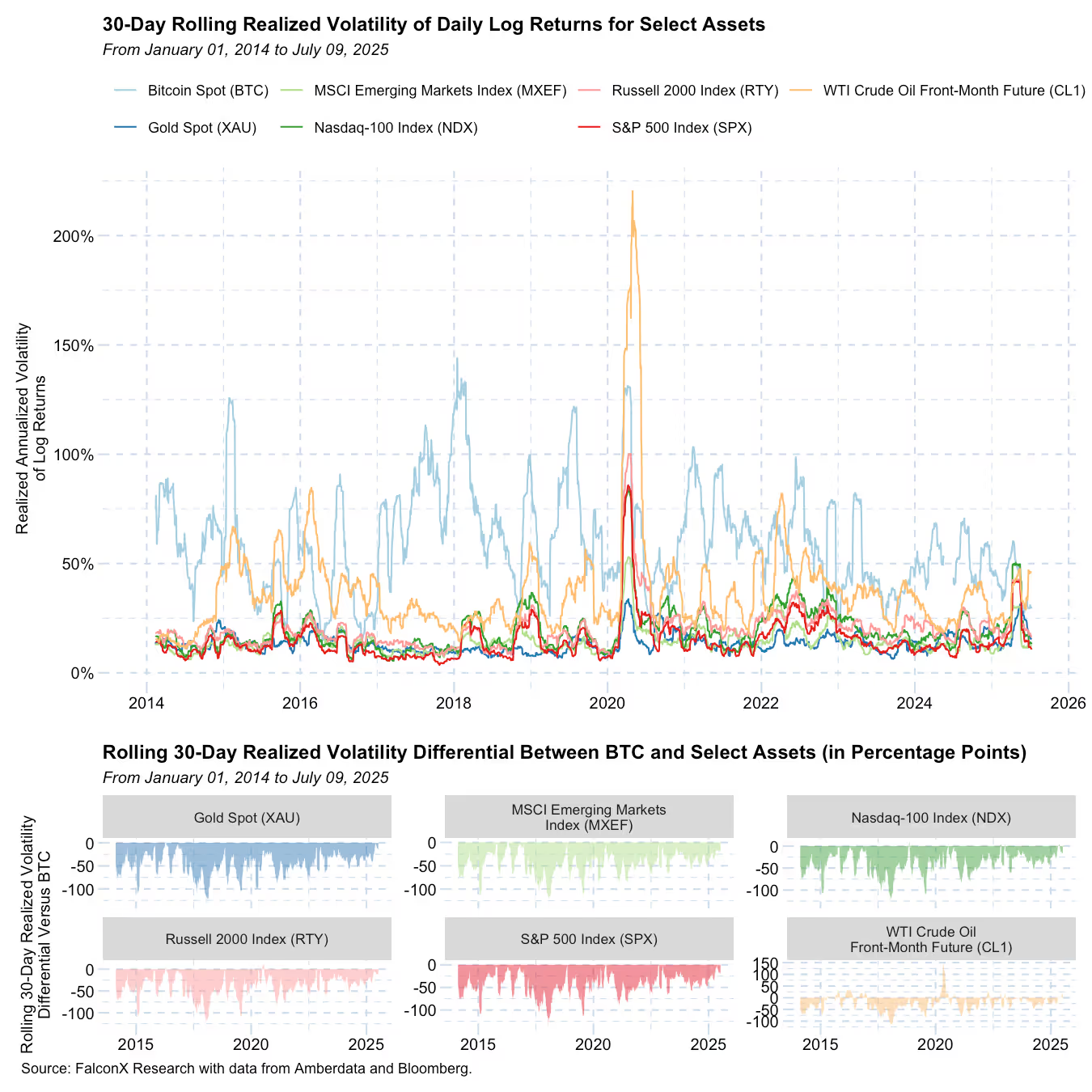BTC’s Orderbook Dynamics Signal a Structurally Different All-Time High Breakout
BTC all-time high breakouts are always exhilarating. But they can also be deceptive, particularly given that the last breakout earlier this year led to a prolonged period of sideways drift. Orderbook dynamics offer a useful lens for assessing what kind of breakout we’re actually seeing.

Despite various potential market-moving news flow across the board, BTC has traded in an
unusually quiet range over the couple of weeks until just yesterday.
There has been news in the convergence between crypto and traditional markets, with Robinhood announcing the launch of tokenized stocks, perpetual futures, and an Arbitrum-based L2. The U.S. House of Representatives is also gearing up for the upcoming Crypto Week, in which they will consider the CLARITY Act on crypto market structure, the GENIUS Act on stablecoin legislation, and the Anti-CBDC Surveillance Act. All the while, the pace of announcements from crypto treasury companies remains frenetic (ReserveOne, BitMine, and Binance founder CZ backing an upcoming BNB treasury company, just to cite a few of the most noteworthy).
Still, Bitcoin’s realized volatility has remained subdued. The chart below plots the 30-day realized volatility of BTC relative to major asset classes since 2014. While it is widely acknowledged that BTC’s absolute volatility ranks low by historical standards, fewer market observers fully appreciate just how muted it has been relative to more traditional asset classes.
The small charts beneath the main chart highlight this differential. BTC’s volatility has seldom been this compressed versus the key equity indexes and commodities. Notably, BTC is currently exhibiting lower realized volatility than crude oil, an asset traditionally viewed as significantly less volatile.

This market regime may be on the verge of shifting. As this note goes to press, Bitcoin is breaking through its all-time highs, cracking above the $118k level. Ethereum has rallied 18% in the past 24 hours and now hovers around the $3,000 mark.
Liquidity trends often offer valuable insight into potential market regime shifts.
The chart below illustrates the BTC spot orderbook depth at the 0.5% level across some of the main exchanges characterized by higher levels of directional trading activity. The right panel shows depth in U.S. dollar terms, while the right presents the same measure in native units. Observers of orderbook dynamics will recognize that BTC’s market depth has remained remarkably stable in native units across a range of market conditions.

Transitions between market regimes, however, often bring shifts in microstructure.
Orderbooks (in native units) tend to tighten, potentially reflecting market makers and other participants widening spreads while awaiting greater clarity on the emerging range. This dynamic was evident during prior regime changes, such as in the lead-up to the BTC spot ETF launch and the post-election rally that followed the 2024 presidential outcome.
While not a leading indicator, changes in market depth serve as a useful early confirmation tool to contextualize broader moves. Thus far, orderbook liquidity has not contracted meaningfully. However, it remains a key variable to monitor for signs that this all-time-high breakout is structurally different from the one earlier in the year.
Another, often overlooked, way to analyze the BTC orderbook is through the bid-ask skew ratio, defined here as the depth on the bid side divided by the depth on the ask side at a certain point in time. A ratio above one indicates greater buy-side liquidity relative to sell-side, suggesting more latent demand, while a ratio below one implies the opposite.
This measure can be particularly useful for identifying future short-term mean-reversion dynamics.
The chart below displays BTC orderbook skew using the same parameters as the previous chart (0.5% depth). The shaded gray areas highlight periods when the BTC price was within 5% of its all-time high at the time, while the green vertical lines mark instances of new all-time-high breakouts.

Historically, this indicator has proven most useful as a contrarian signal.
BTC’s most explosive rallies have tended to emerge during periods when the orderbook skew significantly remained below one (in recent history meaning below 0.9, indicating sell-side pressure) for an extended time. This pattern likely reflects sustained profit-taking around key psychological levels.
Once that overhead supply is absorbed, however, the path for more aggressive upside typically opens up. Conversely, elevated levels of buy-side skew (in recent history meaning above 1.1), are usually associated with price consolidation or corrections.
Currently, the orderbook skew has remained low for nearly four months, an unusually long stretch by the standards of this market cycle. This prolonged standoff can be seen as a measurable expression of the “coiled spring” dynamic. Crucially, the orderbook skew still remains below one, or well below levels associated with buy-side excess, suggesting that the current rally may still have room to extend before encountering meaningful resistance.
BTC all-time high breakouts are always exhilarating. But they can also be deceptive, particularly given that the last breakout earlier this year led to a prolonged period of sideways drift.
Orderbook dynamics offer a useful lens for assessing what kind of breakout we’re actually seeing.
Much can shift quickly in crypto markets, especially in a macro environment as fluid as this one. But so far, the current all-time high breakout is showing signs of being structurally different from the last. Buckle up. This is a constructive signal for what’s likely to come.
This material is for informational purposes only and is only intended for sophisticated or institutional investors. Neither FalconX Limited, FalconX Bravo, Inc., FalconX Delta, Inc., FalconX Foxtrot Pte Ltd., FalconX Golf Pte Ltd., Solios, Inc., Falcon Labs, Ltd., KestrelX, Ltd., nor Banzai Pipeline Limited (separately and collectively “FalconX”) service retail counterparties, and the information on this website is NOT intended for retail investors. The material published on this website is not (i) an offer, or solicitation of an offer, to invest in, or to buy or sell, any interests or shares, or to participate in any investment or trading strategy, (ii) intended to provide accounting, legal, or tax advice, or investment recommendations, or (iii) an official statement of FalconX or any of its affiliates. Any information contained in this website is not and should not be regarded as investment research, debt research, or derivatives research for the purposes of the rules of the CFTC or any other relevant regulatory body.
Prior to entering into any proposed transaction, recipients should determine, in consultation with their own investment, legal, tax, regulatory, and accounting advisors, the economic risks and merits, as well as the legal, tax, regulatory and accounting characteristics and consequences of the transaction. Pursuant to the Dodd-Frank Act, over-the-counter derivatives are only permitted to be traded by "eligible contract participants" (“ECP”s) as defined under Section 1a(18) of the CEA (7 U.S.C. § 1a(18)). Do not consider derivatives or structured products unless you are an ECP and fully understand and are willing to assume the risks.
Solios, Inc. and FalconX Delta, Inc. are registered as federal money services businesses with FinCEN. FalconX Bravo, Inc. is registered with the U.S. Commodities Futures Trading Commission (CFTC) as a swap dealer and a member of the National Futures Association. FalconX Limited, FalconX Bravo, Inc., FalconX Delta, Inc., Falcon Labs Ltd., and Solios, Inc. are not registered with the Securities & Exchange Commission or the Financial Industry Regulatory Authority. FalconX Golf Pte. Ltd. is not required to be registered or licensed by the Monetary Authority of Singapore (MAS). MAS has granted FalconX Foxtrot Pte. Ltd. a temporary exemption from holding a license under the PSA for the payment services caught under the expanded scope of regulated activities for a specified period. FalconX Limited is a registered Class 3 VFA service provider with the Malta Financial Services Authority under the Virtual Financial Assets Act of 2018. FalconX Limited is licensed to provide the following services to Experienced Investors, Execution of orders on behalf of other persons, Custodian or Nominee Services, and Dealing on own account. FalconX’s complaint policy can be accessed by sending a request to complaints@falconx.io
"FalconX" is a marketing name for FalconX Limited and its affiliates. Availability of products and services is subject to jurisdictional limitations and capabilities of each FalconX entity. For information about which legal entities offer trading products and services, or if you are considering entering into a derivatives transaction, please reach out to your Sales or Trading representative.



